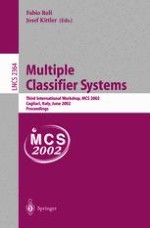2002 | Buch
Multiple Classifier Systems
Third International Workshop, MCS 2002 Cagliari, Italy, June 24–26, 2002 Proceedings
herausgegeben von: Fabio Roli, Josef Kittler
Verlag: Springer Berlin Heidelberg
Buchreihe : Lecture Notes in Computer Science
Enthalten in: Professional Book Archive
